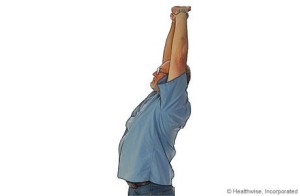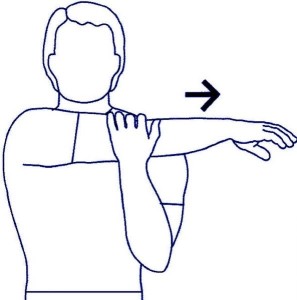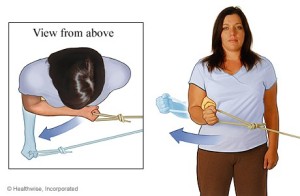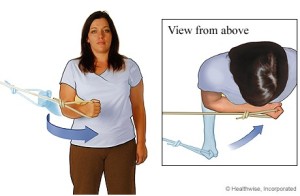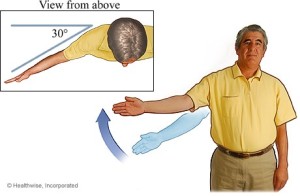Like it or not, stretching is paramount to injury management as it helps release tension in the joint, which is especially crucial after an intense workout. Just like low back pain, shoulder pain is a common complaint amongst individuals from non-athletes to professional athletes. Shoulder pain includes any pain that arises in or around your shoulder. Shoulder pain may originate in the joint itself, or from any of the many surrounding muscles, ligaments or tendons. Shoulder pain usually worsens with activities or movement of your arm or shoulder.
Shoulder stretching, when done appropriately improves range of motion and allows one to return to normal activity level. Shoulder strengthening exercises creates more stability at the shoulder capsule joint reducing the chances of injuries. Undoubtedly, proper medical advice should be sought upon occurrence of pain. Below are 3 easy stretches that you can do wherever and whenever to ease shoulder ache and fatigue.
Stretches
1. Shoulder and Chest Stretch
Stand in a doorway and place one arm against the door frame, as shown in the picture. Your elbow should be a little higher than your shoulder. Relax your shoulders as you lean forward, allowing your chest and shoulder muscles to stretch. You can also turn your body slightly away from your arm to stretch the muscles even more. Hold for 15 to 30 seconds. Repeat 2 to 4 times with each arm.
2. Overhead stretch
Reach up over your head with both arms. Hold for 15 to 30 seconds. Repeat 2 to 4 times.
3. Abductor and External Rotator stretch
Abductor and External Rotator Stretch
Hold your left arm straight in front of you parallel to the floor, palm facing to the right. With your right arm hold the left forearm and bring the left arm across your chest. Maintain a straight arm while slightly pulling your arm towards your chest. Repeat on the right side. Abductor and External rotator stretch
Hold your left arm straight in front of you parallel to the floor, palm facing to the right. With your right arm hold the left forearm and bring the left arm across your chest. Maintain a straight arm while slightly pulling your arm towards your chest. Repeat on the right side. Abductor and External rotator stretch
Hold your left arm straight in front of you parallel to the floor, palm facing to the right. With your right arm hold the left forearm and bring the left arm across your chest. Maintain a straight arm while slightly pulling your arm towards your chest. Repeat on the right side.
Strengthening Exercises
1. External Rotator
External rotator muscular strength is crucial for overall shoulder joint stability.
- Begin by tying a piece of elastic exercise material, such as surgical tubing or Thera-Band, to a doorknob. (You may also hold one end of the band in each hand.)
- Stand or sit with your shoulder relaxed and your elbow bent 90 degrees. Your upper arm should rest comfortably against your side. You can squeeze a rolled towel between your elbow and your body for comfort and to help keep your arm at your side.
- Hold one end of the elastic band with the hand of the affected arm.
- Start this exercise with your forearm across your belly. Slowly rotate the forearm out away from your body, keeping your elbow and upper arm tucked against the towel roll or the side of your body until you begin to feel tightness in your shoulder. Slowly move your arm back to where you started.
- Repeat 8 to 12 times.
2.Internal Rotator
Internal rotator muscular (and external rotator) strength is also crucial for overall shoulder joint stability.
- Begin by tying a piece of elastic exercise material, such as surgical tubing or Thera-Band, to a doorknob.
- Stand or sit with your shoulder relaxed and your elbow bent 90 degrees. Your upper arm should rest comfortably against your side. You can squeeze a rolled towel between your elbow and your body for comfort and to help keep your arm at your side.
- Hold one end of the elastic band in the hand of the affected arm.
- Slowly rotate your forearm toward your body until it touches your belly. Slowly move it back to where you started.
- Keep your elbow and upper arm firmly tucked against the towel roll or the side of your body during this movement.
- Repeat 8 to 12 times.
3.Lateral Raises
This exercise targets the medial head of the deltoid muscle. Strengthening this muscle helps with abduction of arm at shoulder joint.
- Slowly raise your injured arm to the side, with your thumb facing up. Raise your arm 60 degrees at the most (shoulder level is 90 degrees).
- After holding the position for 3 to 5 seconds, lower your arm back to your side. If you need to, bring your “good” arm across your body and place it under the elbow as you lower your injured arm. Use your good arm to keep your injured arm from dropping down too fast during the downward motion.
- Repeat 8 to 12 times.
- When you first start out, don’t hold any additional weight in your hand. As your strength improves, you may use a 1 lb to 2 lb (0.5 kg to 1 kg) dumbbell or a small can of food.
Note: During this strengthening exercise your arm should stay about 30 degrees to the front of your side.
References
http://www.webmd.com/fitness-exercise/stretches-to-ease-shoulder-fatigue
http://www.mayoclinic.org/symptoms/shoulder-pain/basics/definition/sym-20050696
http://cargocollective.com/holisticathlete/Shoulder-Strength-Conditioning
http://www.webmd.com/fitness-exercise/arm-raises-to-the-side

